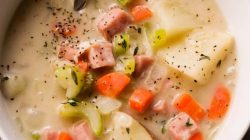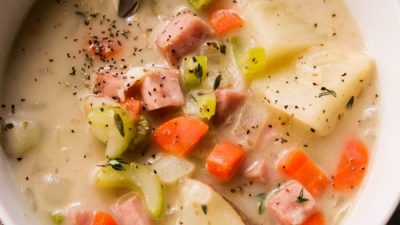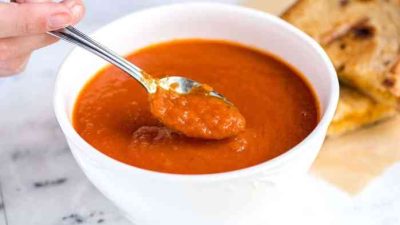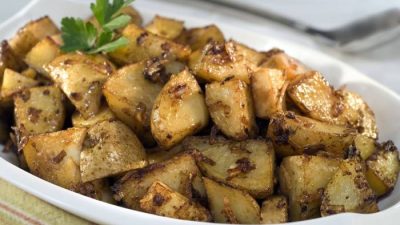Cauliflower and Potato Soup: A Culinary Exploration
Recipe for cauliflower and potato soup – This article delves into the versatile world of cauliflower and potato soup, offering a comprehensive guide to variations, cooking techniques, ingredient substitutions, serving suggestions, and nutritional considerations. We’ll explore diverse recipes, methods, and presentations to inspire your culinary creativity.
Creamy cauliflower and potato soup is a comforting classic, perfect for a chilly evening. If you’re looking for something a bit heartier, however, you might consider a richer option like the recipe for authentic albondigas soup , which offers a flavorful broth and tender meatballs. But for a lighter, vegetarian alternative, the cauliflower and potato soup remains a delicious choice.
Recipe Variations
The beauty of cauliflower and potato soup lies in its adaptability. Numerous variations cater to different palates and dietary needs. Below, we explore three distinct spice levels, potato types, cauliflower varieties, and a vegan option.
- Mild Cauliflower and Potato Soup: This version emphasizes the natural sweetness of the vegetables. Use Yukon Gold potatoes for their creamy texture and a light touch of herbs like thyme and rosemary.
- Medium-Spiced Cauliflower and Potato Soup: Introduce a warming spice blend like cumin, coriander, and a pinch of cayenne pepper for a subtle heat. Russet potatoes provide a hearty base.
- Spicy Cauliflower and Potato Soup: For those who enjoy a kick, incorporate a generous amount of chili flakes, chipotle powder, or even a diced jalapeño. Red potatoes add a slightly earthy counterpoint to the spice.
- Potato Variety Exploration: Russet potatoes offer a fluffy texture, Yukon Golds bring creaminess, and red potatoes add a subtle earthiness. Experiment to find your favorite!
- Cauliflower Variety Exploration: Romanesco cauliflower’s fractal pattern adds visual interest, while purple cauliflower introduces a vibrant hue and a slightly sweeter taste compared to the standard white variety.
- Vegan Cauliflower and Potato Soup: Replace dairy cream with coconut milk or cashew cream for a rich, creamy texture without any animal products. Vegetable broth forms the base, and nutritional yeast can add a cheesy flavor.
Cooking Methods & Techniques
Achieving the perfect cauliflower and potato soup depends on the chosen cooking method and techniques for achieving desired texture and flavor.
- Stovetop vs. Slow Cooker: The stovetop method offers quicker preparation, allowing for immediate adjustments to seasoning and consistency. The slow cooker yields a more tender and deeply flavored soup, ideal for busy schedules.
- Creating a Creamy Texture Without Cream: Pureeing the soup thoroughly with an immersion blender creates a naturally creamy consistency. Adding a touch of vegetable broth or potatoes towards the end of cooking can further enhance the creaminess.
- Immersion Blender vs. Regular Blender: An immersion blender allows for direct blending in the pot, avoiding the need for transferring hot soup and minimizing the risk of burns. A regular blender requires careful transfer and potentially venting to avoid pressure buildup.
- Roasting Cauliflower and Potatoes: Roasting the vegetables before adding them to the soup intensifies their flavor and creates a slightly caramelized edge. Toss them with olive oil, salt, pepper, and any desired herbs before roasting at 400°F (200°C) for about 20-25 minutes, until tender and slightly browned.
Ingredient Substitutions & Additions
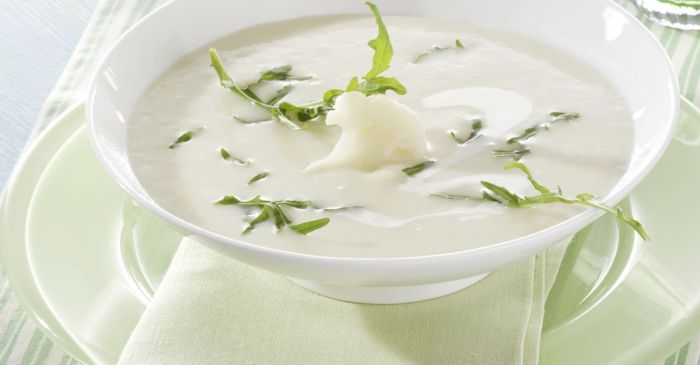
Source: eatsmarter.com
This section explores suitable substitutes and additions to enhance the flavor profile of your cauliflower and potato soup.
- Substitutes: Sweet potatoes can replace potatoes for added sweetness, while parsnips offer a subtly sweet and earthy flavor. Other root vegetables like turnips or carrots can also be incorporated.
- Optional Ingredients: Fresh herbs (parsley, chives, dill), spices (curry powder, smoked paprika), and cheeses (cheddar, Gruyère) can enhance the soup’s flavor profile.
- Broth Types: Chicken broth adds richness, vegetable broth maintains a lighter flavor, and beef broth provides a savory depth. Experiment to find your preferred taste.
- Adding Protein: Sausage, bacon, or lentils can be added for a heartier soup. Cook the protein separately before incorporating it into the soup.
Serving Suggestions & Presentation
The presentation of your cauliflower and potato soup can significantly impact the dining experience. Here are a few ideas to elevate your presentation.
- Presentation Ideas: Garnish with croutons, fresh herbs, a swirl of cream (or vegan alternative), or roasted cauliflower florets.
- Side Dish Suggestions: Crusty bread, a simple green salad, or grilled cheese sandwiches pair well with the soup.
- Serving Temperatures:
- Visual Appeal: The contrast between the creamy white soup and vibrant green herbs, or the addition of colorful roasted vegetables, creates a visually appealing dish.
| Serving Temperature | Flavor Impact | Texture Impact | Notes |
|---|---|---|---|
| Hot | Enhanced spices and aromas | Creamy and comforting | Classic serving style |
| Room Temperature | More subtle flavors | Slightly thicker consistency | Suitable for picnics or potlucks |
| Cold | Fresh and refreshing | Thicker, almost chilled pudding-like | Unique option, best with herbs |
Nutritional Information & Dietary Considerations
Understanding the nutritional content and making necessary modifications ensures the soup suits various dietary needs.
- Nutritional Breakdown (Approximate): A standard serving (about 1.5 cups) might contain roughly 250-300 calories, 10-15g fat, 10-15g protein, and 30-40g carbohydrates. These values vary depending on ingredients and portion size.
- Gluten-Free and Dairy-Free Modifications: Use gluten-free broth and dairy-free alternatives like coconut milk or cashew cream for a dairy-free and gluten-free version.
- Potential Allergens: Common allergens include dairy (milk, cream, cheese), gluten (in some broths), and nuts (if using nut-based cream). Always check ingredient labels carefully.
- Dietary Restrictions: For low-sodium diets, use low-sodium broth and reduce added salt. For low-carb diets, reduce the amount of potatoes and add more cauliflower.
Recipe Storage & Leftovers, Recipe for cauliflower and potato soup

Source: ciaoflorentina.com
Proper storage ensures the longevity and quality of your leftover cauliflower and potato soup.
- Storage Methods: Store leftovers in airtight containers in the refrigerator for up to 3-4 days or in the freezer for up to 2-3 months.
- Reheating: Gently reheat the soup on the stovetop or in the microwave, avoiding boiling. Stir frequently to prevent scorching.
- Using Leftovers: Leftover soup can be used as a base for casseroles, or as a filling for baked potatoes or bread bowls.
- Shelf Life: Refrigerated soup lasts longer than frozen soup. Always check for signs of spoilage before consuming.
FAQs: Recipe For Cauliflower And Potato Soup
Can I use frozen cauliflower and potatoes?
Yes, frozen vegetables work well. Just ensure they are fully thawed and drained before adding them to the soup to prevent excess water.
How long does the soup last in the refrigerator?
Properly stored in an airtight container, the soup will typically last for 3-4 days in the refrigerator.
Can I make this soup ahead of time?
Absolutely! This soup tastes even better the next day. Make it ahead and store it in the refrigerator for a quick and easy meal.
What are some good bread pairings for this soup?
Crusty bread, sourdough, or even a simple baguette are excellent choices for dipping into this flavorful soup.




